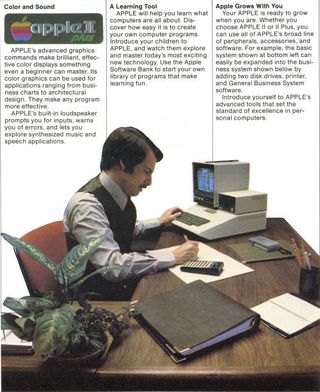Apple at 30: The first moments with the Apple II
The showdown that set the stage

On the absolute razor's edge of a revolution, this ad shows an Apple computer, for the first time, being used the way that came to define Apple as a technology. From the classifieds section of Creative Computing, December 1982.
The day it became clearest to me that the world was a different place for the rest of my life, came in September of 1978. By that time, I was an adept Radio Shack TRS-80 Level II BASIC programmer, programming little demos that Tandy's stores were using throughout the Southwest US to promote their systems. During one of the many computer conferences that defined the way we introduced ourselves to the world during this time, the big question among the attendees that fall was, whose computer played the best round of chess? I believed I knew the answer to that: "Microchess" was a program co-written by Bill Gates for the TRS-80. Meanwhile, at a display sponsored by the first truly superb computer store I ever patronized, called "High Technology," a fellow insisted that a newly imported set of routines for the Apple, called Sargon, could dissolve this Microsoft chess program into a mass of low-resolution, white bricks.
Thus the High Technology folks and the Tandy people staged an impromptu chess match. Microchess was white, Sargon black. We agreed to set our skill levels to maximum. As a result, each move consumed as much as five minutes of "thinking" time. That day, I wore my Orbach's-tailored blue blazer with a silk necktie, meticulously designed to make me look much, much older than I was. So as I served as the unofficial diplomat, running back and forth along the 60 yards or so of distance between each booth to report chess moves, I noticed two sets of crowds were building up, one around the Apple II, the other around the TRS-80. Because each move took five minutes, there was plenty of time for the crowds to gather.
The first game, believe it or not, ended in a stalemate. Sargon and Microchess got stuck in a rut, repeating the same series of four moves over and over again. So we had to start over, and in the second match, Sargon surprisingly won handily, in about 45 minutes. High Technology handed out T-shirts with Apple logos to celebrate.
As the crowds finally began to disperse, those who remained included a few local reporters. One asked me, what is this? Is this a video game or a computer? It looks real, whatever it is. Indicating the beige wedge, I explained it was an Apple II, and conceded it was probably among the finest computing devices ever built. "So what does it do," I was asked, "besides play chess?" I tried a phrase that I had devised over the countless hundreds of times I'd been asked that question, usually to explain another program it ran called VisiCalc: "If you have the skill and the patience," I said, "to provide an Apple II with the information that pertains to your business, and some of the logic that defines how your business works, it can make sense of that information so that you see it and understand it in ways you haven't before."
"No, I still don't get it," came the reply. That's the day, and perhaps the moment, that I realized that I would be devoting a good deal of my life to providing a clear response to that question. This is how the Apple II changed me, the people around me, and the world we were just then learning to share.

The first sales brochures for the Apple II couldn't fare much better at explaining what they did, or how they functioned, than I or anyone else at the time. All this particular brochure could do is reassure its reader that "APPLE will help you learn what computers are all about," which was shorthand for, "When we figure it out, we'll let you know." The first models brought in by ad agencies to pose next to computers, had no idea how real computer users should look, or what these machines were actually doing. So to make this scene look business-like, the agency added 1) a ledger book and 2) a calculator, to help cue the viewer that business was taking place here...forgetting all the while that these were the devices that the computer should come to replace. This particular model, I used to joke, must have really wanted to "escape" this scene - notice where his left hand is.
Stay on the Cutting Edge
Join the experts who read Tom's Hardware for the inside track on enthusiast PC tech news — and have for over 25 years. We'll send breaking news and in-depth reviews of CPUs, GPUs, AI, maker hardware and more straight to your inbox.
Most Popular

